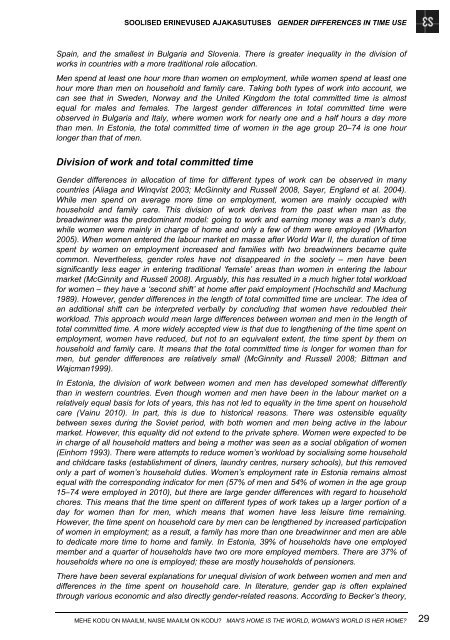MEHE KODU ON MAAILM, NAISE MAAILM ON KODU? - Tartu Ãlikool
MEHE KODU ON MAAILM, NAISE MAAILM ON KODU? - Tartu Ãlikool
MEHE KODU ON MAAILM, NAISE MAAILM ON KODU? - Tartu Ãlikool
Create successful ePaper yourself
Turn your PDF publications into a flip-book with our unique Google optimized e-Paper software.
SOOLISED ERINEVUSED AJAKASUTUSES GENDER DIFFERENCES IN TIME USE<br />
Spain, and the smallest in Bulgaria and Slovenia. There is greater inequality in the division of<br />
works in countries with a more traditional role allocation.<br />
Men spend at least one hour more than women on employment, while women spend at least one<br />
hour more than men on household and family care. Taking both types of work into account, we<br />
can see that in Sweden, Norway and the United Kingdom the total committed time is almost<br />
equal for males and females. The largest gender differences in total committed time were<br />
observed in Bulgaria and Italy, where women work for nearly one and a half hours a day more<br />
than men. In Estonia, the total committed time of women in the age group 20–74 is one hour<br />
longer than that of men.<br />
Division of work and total committed time<br />
Gender differences in allocation of time for different types of work can be observed in many<br />
countries (Aliaga and Winqvist 2003; McGinnity and Russell 2008, Sayer, England et al. 2004).<br />
While men spend on average more time on employment, women are mainly occupied with<br />
household and family care. This division of work derives from the past when man as the<br />
breadwinner was the predominant model: going to work and earning money was a man’s duty,<br />
while women were mainly in charge of home and only a few of them were employed (Wharton<br />
2005). When women entered the labour market en masse after World War II, the duration of time<br />
spent by women on employment increased and families with two breadwinners became quite<br />
common. Nevertheless, gender roles have not disappeared in the society – men have been<br />
significantly less eager in entering traditional ‘female’ areas than women in entering the labour<br />
market (McGinnity and Russell 2008). Arguably, this has resulted in a much higher total workload<br />
for women – they have a ‘second shift’ at home after paid employment (Hochschild and Machung<br />
1989). However, gender differences in the length of total committed time are unclear. The idea of<br />
an additional shift can be interpreted verbally by concluding that women have redoubled their<br />
workload. This approach would mean large differences between women and men in the length of<br />
total committed time. A more widely accepted view is that due to lengthening of the time spent on<br />
employment, women have reduced, but not to an equivalent extent, the time spent by them on<br />
household and family care. It means that the total committed time is longer for women than for<br />
men, but gender differences are relatively small (McGinnity and Russell 2008; Bittman and<br />
Wajcman1999).<br />
In Estonia, the division of work between women and men has developed somewhat differently<br />
than in western countries. Even though women and men have been in the labour market on a<br />
relatively equal basis for lots of years, this has not led to equality in the time spent on household<br />
care (Vainu 2010). In part, this is due to historical reasons. There was ostensible equality<br />
between sexes during the Soviet period, with both women and men being active in the labour<br />
market. However, this equality did not extend to the private sphere. Women were expected to be<br />
in charge of all household matters and being a mother was seen as a social obligation of women<br />
(Einhorn 1993). There were attempts to reduce women’s workload by socialising some household<br />
and childcare tasks (establishment of diners, laundry centres, nursery schools), but this removed<br />
only a part of women’s household duties. Women’s employment rate in Estonia remains almost<br />
equal with the corresponding indicator for men (57% of men and 54% of women in the age group<br />
15–74 were employed in 2010), but there are large gender differences with regard to household<br />
chores. This means that the time spent on different types of work takes up a larger portion of a<br />
day for women than for men, which means that women have less leisure time remaining.<br />
However, the time spent on household care by men can be lengthened by increased participation<br />
of women in employment; as a result, a family has more than one breadwinner and men are able<br />
to dedicate more time to home and family. In Estonia, 39% of households have one employed<br />
member and a quarter of households have two ore more employed members. There are 37% of<br />
households where no one is employed; these are mostly households of pensioners.<br />
There have been several explanations for unequal division of work between women and men and<br />
differences in the time spent on household care. In literature, gender gap is often explained<br />
through various economic and also directly gender-related reasons. According to Becker’s theory,<br />
<strong>MEHE</strong> <strong>KODU</strong> <strong>ON</strong> <strong>MAAILM</strong>, <strong>NAISE</strong> <strong>MAAILM</strong> <strong>ON</strong> <strong>KODU</strong>? MAN’S HOME IS THE WORLD, WOMAN’S WORLD IS HER HOME? 29

















